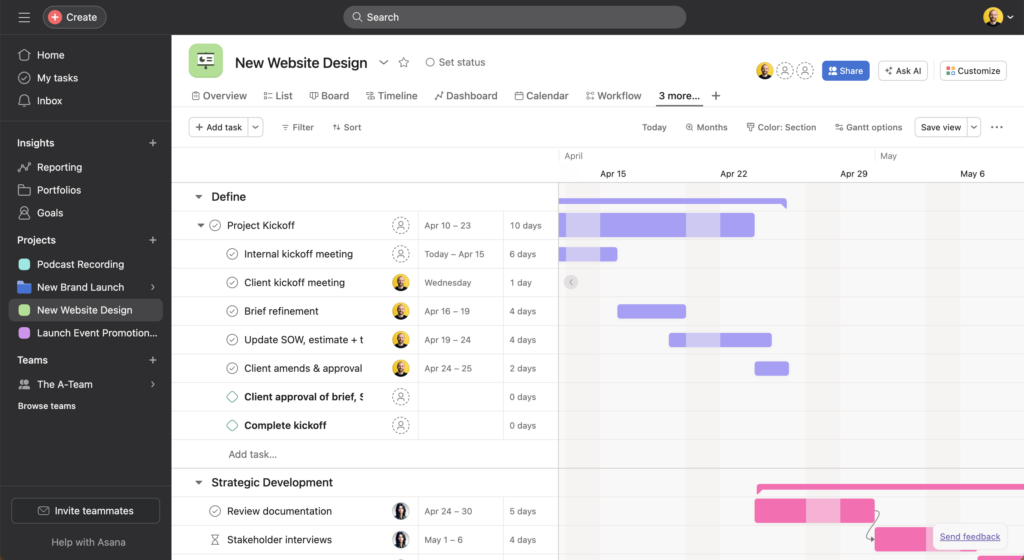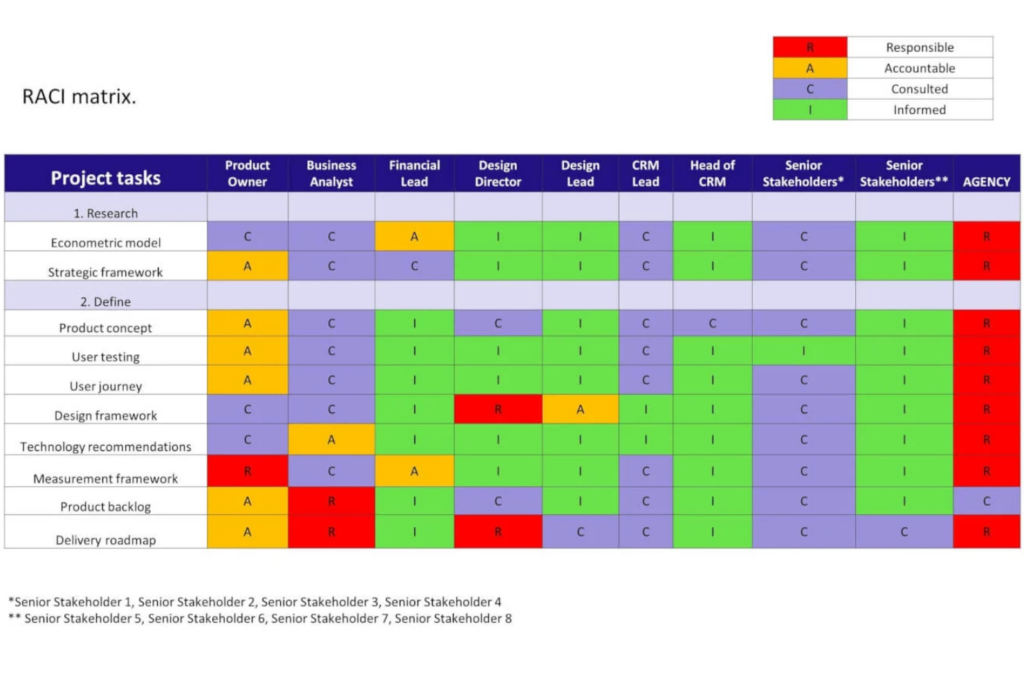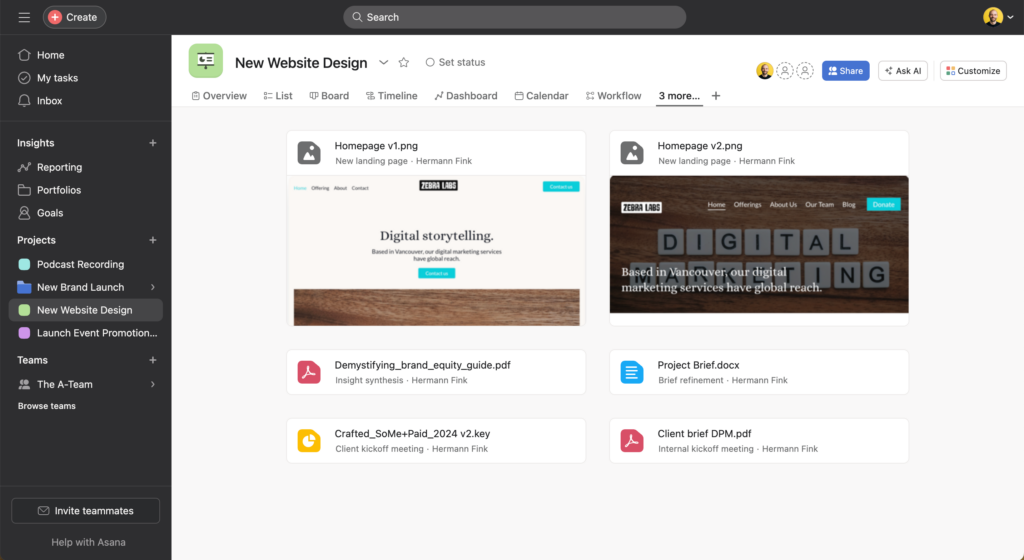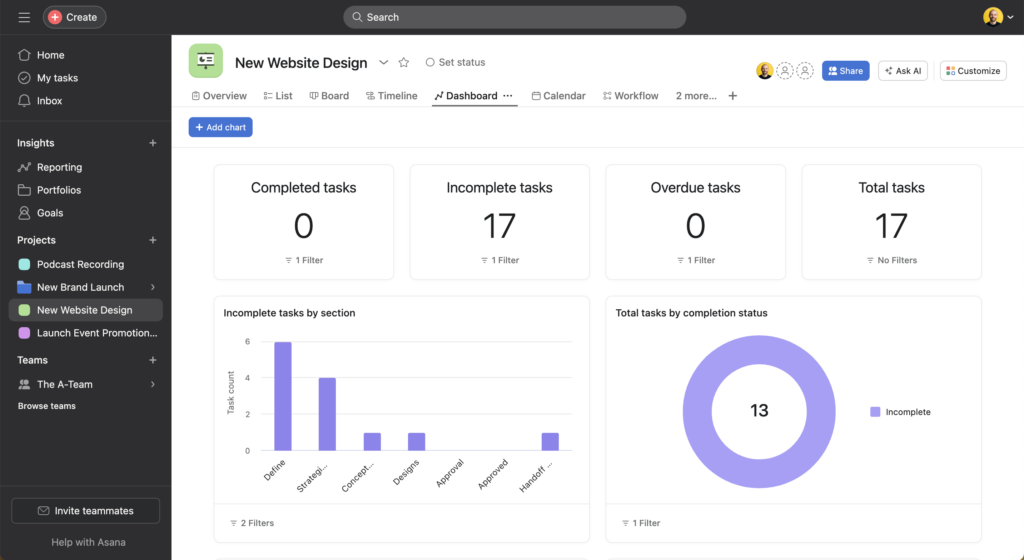Project visibility is the looking glass that project managers use to understand and share a project’s status, progress, and potential hurdles. Without it, you and your stakeholders are left guessing, which can lead to missed deadlines, budget overruns, and a stressed-out team. It's like like having a real-life crystal ball that can help you anticipate and tackle risks head-on, keeping your projects on track and within budget.
In this article, we’ll dive into real-world examples of how project management software can bring project visibility to life. I’ll share tips on optimizing workflows and show you how to build visibility into every aspect of your project— from clearly defining roles and responsibilities to offering actionable measures for tracking and forecasting.
By the end of this guide, you’ll have practical tips and tools to make project visibility a reality.
What Is Project Visibility?
Project visibility refers to the clear and comprehensive understanding of a project's status, progress, and potential obstacles by all project stakeholders.
It ensures everyone, from team members to upper management, can access up-to-date information on key metrics, deadlines, and deliverables, thus enhancing project performance and keeping projects on track.
For example, tools like Jira or Trello transparently log and track tasks, bugs, dependencies, and updates in software development. Team members see which tasks are completed, active, or overdue, facilitating the identification of bottlenecks and enhancing overall project management.
Benefits of Project Visibility
Project visibility is essential for effective project management. The benefits collectively elevate productivity and ensure successful project outcomes.
- Streamlined communication: When all stakeholders access the same information, through dashboard tools and reports, you streamline communication and enable decision-making.
- Heightened accountability: True project visibility allows all team members to track and update tasks live. Communal visibility drives a level of accountability, especially where there are dependencies.
- Proactive risk mitigation: Real-time monitoring of progress and risk status supports teams in identifying and addressing issues early, giving you a glimpse into the possibilities of the future while enabling you to steer the ship.
- Optimized resource management: Clear visibility into the total resources allocated to a project allows for more efficient and strategic use of project resources, which drives productivity and project health while reducing waste.
- Requirements alignment: Deliverables are tangible and easily realized through project visibility, ultimately bringing clarity to the requirements of the tasks at hand as they relate to project goals. Visibility aligns people with requirements. When you achieve this, you effectively have a crystal ball foretelling project performance.
How To Improve Project Visibility
Project visibility is critical for projects to be effective (doing the right things) and efficient (doing the right things well).
1. Plan
A project plan is a comprehensive guide outlining objectives, deliverables, timelines, communication strategies, and resources. Planning ahead provides a visible framework that you and the team can compare against your progress throughout the project. If you’re not one for minutiae, begin with a broad perspective and break down the project goal into manageable steps.
Are you tasked with planning a marketing campaign? Consider categories such as planning, conceptualizing, content creation, asset gathering, design, review, launch, and metrics tracking. Dissect each category to determine the necessary steps to reach your goal, their timing, and the required quality standards.
Assess your resources, consider team availability, and determine whether specific tasks can be executed concurrently, as this will inform your project task structure and resource allocation strategy.
The following example is of a marketing campaign planned using Asana. This platform offers a comprehensive view of all the moving parts in one place: project resources, milestones and tasks, due dates, and status. This level of transparency propels successful project execution.

2. Use Project Management Software
Leveraging the right project management software is the foundation of improving project visibility. Tools like Microsoft Project, Trello, and Asana provide a centralized platform where all project-related information is accessible. These platforms offer real-time updates, tasks, time tracking, and most importantly, comprehensive reporting features.
Using your software of choice, reference your project plan and create the appropriate categories, milestones, and tasks involved. Assign your resources, upload relevant project documents, and assign due dates to every individual task. Using the reporting feature, you will see the progress status.

In the example above, an Asana project dashboard visually summarizes task status and team member task allocation.
This allows you to see the volume of tasks completed by a department or team member, the volume of tasks allocated per person, the amount of completed and outstanding tasks, and which tasks are on-time or at-risk.
Best Project Management Software
The best tools to manage and control projects and teams more effectively.
3. Identify Clear Roles & Responsibilities
Defining clear roles and responsibilities ensures everyone knows their specific duties and how they contribute to the project. To delineate roles clearly, create a RACI matrix (which stands for responsible, accountable, consulted, and informed).
In the example below, a RACI matrix shows roles across different tasks and project phases. Each cell indicates the role of a team member in that task. The RACI matrix clarifies responsibilities and prevents overlap or confusion. Team members focus on specific tasks and refer to the RACI to understand who to consult or inform.

4. Documentation and Reporting
It is crucial to maintain clear and appropriately accessible documentation of all project assets. Increasingly, project management tools offer simple options to enhance visibility on project assets or integrations with file storage solutions such as Google Drive or DropBox.
The example below shows document storage within a project management tool, in this case, Asana. We see organized folders for different aspects of the project, such as audio and blog posts.
This organization makes it easy for team members to access information to efficiently execute deliverables while leveraging the benefits of centralized visibility in a project management tool.

5. Regularly Report On Project Status
Regular status reports keep everyone updated on progress, issues, and upcoming milestones. Many mainstream project management tools automatically generate these reports and offer superb templates that will simplify your reporting.
The example below shows a project status report highlighting pertinent project elements such as progress, assignee, and urgency. This comprehensive report provides a snapshot of the project’s health, enabling stakeholders to grasp the status and make informed decisions quickly.

6. Use Automation
Automation streamlines repetitive tasks and can support consistency in project management processes. Tools like Zapier, or built-in automation features in project management software, can automate updates, notifications, and task assignments.
Task or process automation cuts project delivery time and reduces risks rooted in human error, ensuring that project updates and communications are consistent and timely. Utilizing automation can improve project visibility in your organization, leading to better communication, accountability, and overall project success.
Tools For Improving Project Visibility
Enhancing project visibility is essential for effective project management and efficient stakeholder engagement. Tools such as Jira, Trello, Asana, Microsoft Project, and monday.com are invaluable, providing centralized platforms for real-time access and updates on all project information.
These tools support task tracking, transparent documentation, and automated reporting, offering a comprehensive view of project progress and potential issues. By utilizing project management software tools, project managers can access important information and make strategic decisions that guide present actions into future successes.
Common Obstacles To Clear Project Visibility
Effective project management requires clear visibility into project status, yet several challenges can limit clarity.
1. Scope Creep
Scope creep arises when unanticipated requirements infiltrate a project, disrupting schedules and budgets.
Solution:
- Begin by meticulously defining project goals and requirements
- Document them in a comprehensive scope document, securing client sign-off
- Regularly monitor progress against the original scope to prevent last-minute changes from derailing deadlines
2. Silos Between Team Members
Teams often get siloed in their own tasks and departments, and sometimes miss insights into project status and progress.
Solution:
- Break down silos by fostering communication and collaboration
- Leverage integrated tools to consolidate information
- Strengthen project planning and emphasize thorough documentation and data transparency
3. Effective Time Management
Project managers need help strategically allocating time and prioritizing tasks.
Solution:
- Optimize time allocation by making time visible on a Gantt
- Allocate resources strategically based on availability, budget, skill, and requirements
- Establish realistic deadlines
- Regularly assess progress and adjust schedules as needed
4. Stakeholder Communication Challenges
Time spent updating and communicating with stakeholders can be redundant, cumbersome, and out of scope.
Solution:
- Streamline communication channels
- Provide regular, concise updates
- Ensure stakeholders know their roles and expectations to maintain efficient project flow
5. Over Reliance on Manual Tracking
Relying on whiteboards or manual methods for progress tracking can lead to errors and mistakes.
Solution:
- Embrace digital project management tools that automate monitoring and reporting. These tools enhance visibility while minimizing administrative overhead.
6. Lack of Risk Management
Inadequate risk assessment and mitigation that puts projects at risk of being over budget, behind schedule, or below quality.
Solution:
- Prioritize risk management during the planning phase (maintain a proactive approach to limit the need for a reactive approach)
- Identify potential risks early and develop realistic contingency plans
- Continually evaluate and address risks throughout the project life cycle
Join For More Project Management Insights
Want to connect with other digital project managers to share resources and best practices? Join our membership community and get access to 100+ templates, samples, and examples, and connect with 100s of other digital project managers in Slack.



